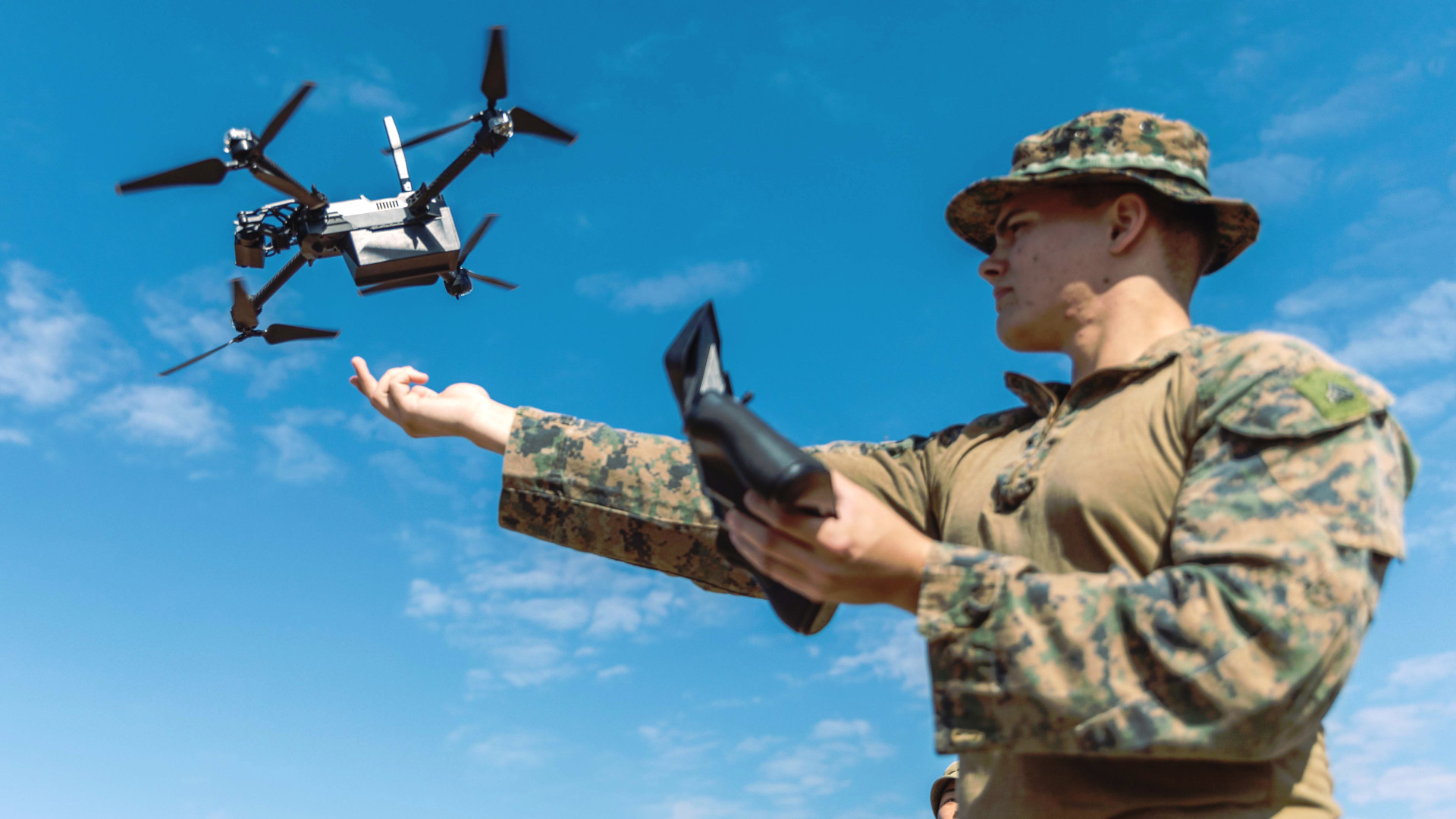The increasing prevalence of weaponized drones, especially first-person-view (FPV) kamikaze types, and other man-portable precision munitions could lead to a change in the U.S. Marine Corps’ famous mantra of “every Marine a rifleman,” according to the general who oversees the training of the service’s new recruits.
Marine Lt. Gen. Benjamin Watson, who is currently head of Marine Corps Training and Education Command (TECOM), talked yesterday about how the evolving nature of modern warfare is also impacting the very core of his service’s warrior ethos. Watson’s remarks came during a panel discussion on Marine Corps modernization at the Navy League’s Sea Air Space 2025 exhibition.
“One of our mantras, kind of bumper stickers, which has real meaning for us culturally as a service, is sort of ‘every Marine [a] rifleman,'” Watson said. Now, “the idea [is] that any Marine, using a precision weapon, can kill somebody who needs killing at ranges up to 500 meters.”

“You think about that, and that’s still important, right, being able to achieve combat overmatch at that echelon,” he added. “But now, if you use technology, that same Marine can be just as lethal at ranges out to 15 to 20 kilometers and beyond.”
“And one of the initiatives we partnered on here is this Marine Corps Attack Drone Team,” the TECOM commander continued. “It started down at Quantico, with the partnership between [the] Marine Corps Warfighting Lab[oratory] and [the] Weapons Training Battalion, and they are using FPV drones, first-person-view drones. And they are paving the way for some of the policy, technology, and fiscal challenges into how we bring these in, at scale, and we turn a rifleman into somebody who cannot just kill an adversary with a precision weapon at 500 meters, but can do it out at 15 to 20 kilometers.”
The Corps first announced the establishment of the experimental Marine Corps Attack Drone Team (MCADT) at the service’s base in Quantico, Virginia, earlier this year.
“The creation of MCADT comes in response to the rapid proliferation of armed first-person-view drone technology and tactics observed in modern conflicts, particularly in Eastern Europe. As emerging threats continue to evolve, the Marine Corps is prioritizing the integration of FPV drone capabilities to enhance lethality and operational effectiveness across the Fleet Marine Force,” according to a press release the Marine Corps put out in March. “MCADT’s impact extends beyond competition. FPV drones offer squad-level lethality up to 20 kilometers for under $5,000, compared to more expensive weapons systems with less capability. This provides a cost-effective and scalable solution for modern combat.”

Per the release, MCADT has three main tasks:
- “Develop and refine armed FPV drone training for Marines across the Total Force.”
- “Inform service-level requirements to ensure the rapid fielding of cutting-edge FPV technologies.”
- “Enhance individual and unit lethality through hands-on instruction during competitive training events.”
As alluded to in the March press release, FPV kamikaze drones, as well as ones capable of dropping small munitions on their targets, are in widespread use on both sides of the ongoing conflict in Ukraine, which has helped popularize their increased use globally by both nation-state armed forces and non-state actors. It is important to note, as TWZ regularly does, that the threats posed by weaponized uncrewed aerial systems, including small modified commercial designs, far predates the war in Ukraine.

FPV drones are not the only kinds of precision munitions individual Marines, or at least very small Marine units, can expect to be armed with in the near future. “Things like Organic Precision Fires [OPF], loitering munitions, one-way-attack drones,” are key modernization priorities for the Corps, Marine Lt. Gen. Eric Austin, head of Marine Corps Forces Command, also said during yesterday’s panel discussion.
The Marine Corps is currently in the process of acquiring multiple tiers of loitering munitions through its OPF effort, including types that individual Marines can employ and larger designs fired from ground vehicles and small watercraft.
Teledyne FLIR Defense’s Rogue 1, seen in the video below, is one of the loitering munitions the Marine Corps is acquiring now.

“If you think about the old movies, videos of people in combat, Marines, soldiers, in combat, they carried a hand grenade or two on their vest, right, that they could throw as far as they could throw it, as accurately as they could throw it,” Marine Maj. Gen. Jason Woodworth, another one of the panelists, said. “Now we’re getting to a point where they’re going to be able to carry a guided hand grenade, throw it up in the air with loiter capability, and somebody behind them is going to be able to guide that to everyone in this room. So everyone in this room has a hand grenade that is guidable onto the four of us up here, right?”

Woodworth, who is currently head of Marine Corps Installations Command and Assistant Deputy Commandant, Installations & Logistics (Facilities), pointed out that Marines are facing down the prospect of opponents with the same kinds of capabilities and will need to be able to defend themselves. The Marine Corps is actively working to acquire an array of counter-drone capabilities to protect installations and units abroad and at home.
Efforts similar to the MCADT aimed at expanding the use of FPVs and other kinds of weaponized drones, particularly among smaller combat units, are also now emerging elsewhere across the U.S. military, including within the U.S. special operations community. Other branches of America’s armed forces are also working to acquire large numbers of loitering munitions, as well.
Collectively, this work continues to highlight how the U.S. military is still very much playing catch-up when it comes to broader fielding of uncrewed capabilities, as well as the means to defend against, even while acknowledging growing global trends.
Depending on how the Marine Corps’ modernization efforts proceed now, it may be long before the service’s “every Marine a rifleman” addage also evolves.
Contact the author: joe@twz.com
